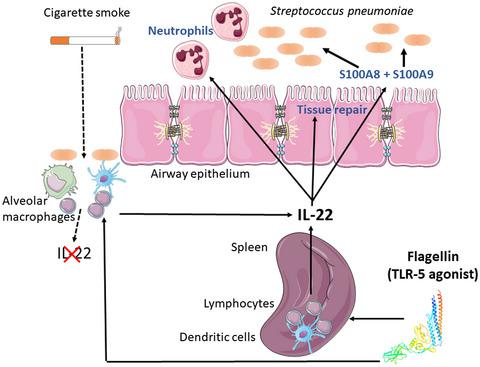当前位置:
X-MOL 学术
›
Clin. Exp. Immunol.
›
论文详情
Our official English website, www.x-mol.net, welcomes your feedback! (Note: you will need to create a separate account there.)
Boosting the IL-22 response using flagellin prevents bacterial infection in cigarette smoke-exposed mice.
Clinical & Experimental Immunology ( IF 4.6 ) Pub Date : 2020-04-23 , DOI: 10.1111/cei.13445 B Koné 1 , M Pérez-Cruz 1 , R Porte 1 , F Hennegrave 1 , C Carnoy 1 , P Gosset 2 , F Trottein 1 , J-C Sirard 1 , M Pichavant 1 , P Gosset 1
Clinical & Experimental Immunology ( IF 4.6 ) Pub Date : 2020-04-23 , DOI: 10.1111/cei.13445 B Koné 1 , M Pérez-Cruz 1 , R Porte 1 , F Hennegrave 1 , C Carnoy 1 , P Gosset 2 , F Trottein 1 , J-C Sirard 1 , M Pichavant 1 , P Gosset 1
Affiliation

|
The progression of chronic obstructive pulmonary disease (COPD), a lung inflammatory disease being the fourth cause of death worldwide, is marked by acute exacerbations. These episodes are mainly caused by bacterial infections, frequently due to Streptococcus pneumoniae . This susceptibility to infection involves a defect in interleukin (IL)‐22, which plays a pivotal role in mucosal defense mechanism. Administration of flagellin, a Toll‐like receptor 5 (TLR‐5) agonist, can protect mice and primates against respiratory infections in a non‐pathological background. We hypothesized that TLR‐5‐mediated stimulation of innate immunity might improve the development of bacteria‐induced exacerbations in a COPD context. Mice chronically exposed to cigarette smoke (CS), mimicking COPD symptoms, are infected with S. pneumoniae , and treated in a preventive and a delayed manner with flagellin. Both treatments induced a lower bacterial load in the lungs and blood, and strongly reduced the inflammation and lung lesions associated with the infection. This protection implicated an enhanced production of IL‐22 and involved the recirculation of soluble factors secreted by spleen cells. This is also associated with higher levels of the S100A8 anti‐microbial peptide in the lung. Furthermore, human mononuclear cells from non‐smokers were able to respond to recombinant flagellin by increasing IL‐22 production while active smoker cells do not, a defect associated with an altered IL‐23 production. This study shows that stimulation of innate immunity by a TLR‐5 ligand reduces CS‐induced susceptibility to bacterial infection in mice, and should be considered in therapeutic strategies against COPD exacerbations.
中文翻译:

使用鞭毛蛋白增强 IL-22 反应可防止暴露于香烟烟雾的小鼠中的细菌感染。
慢性阻塞性肺疾病 (COPD) 是一种肺部炎症性疾病,是全球第四大死因,其进展以急性加重为特征。这些发作主要由细菌感染引起,通常是由肺炎链球菌引起。这种对感染的易感性涉及白细胞介素 (IL)-22 的缺陷,白介素 (IL)-22 在粘膜防御机制中起关键作用。鞭毛蛋白是一种 Toll 样受体 5 (TLR-5) 激动剂,可以保护小鼠和灵长类动物免受非病理背景下的呼吸道感染。我们假设 TLR-5 介导的先天免疫刺激可能会改善 COPD 背景下细菌诱导的恶化的发展。长期暴露于香烟烟雾 (CS) 的小鼠,模仿 COPD 症状,感染了肺炎链球菌 ,并用鞭毛蛋白进行预防和延迟治疗。两种治疗方法都降低了肺部和血液中的细菌负荷,并大大减少了与感染相关的炎症和肺部病变。这种保护作用意味着 IL-22 的产生增加,并涉及脾细胞分泌的可溶性因子的再循环。这也与肺中较高水平的 S100A8 抗微生物肽有关。此外,来自非吸烟者的人类单核细胞能够通过增加 IL-22 的产生来对重组鞭毛蛋白做出反应,而活跃的吸烟者细胞则不会,这是与 IL-23 产生改变相关的缺陷。该研究表明,TLR-5 配体刺激先天免疫可降低 CS 诱导的小鼠细菌感染易感性,
更新日期:2020-04-23
中文翻译:

使用鞭毛蛋白增强 IL-22 反应可防止暴露于香烟烟雾的小鼠中的细菌感染。
慢性阻塞性肺疾病 (COPD) 是一种肺部炎症性疾病,是全球第四大死因,其进展以急性加重为特征。这些发作主要由细菌感染引起,通常是由肺炎链球菌引起。这种对感染的易感性涉及白细胞介素 (IL)-22 的缺陷,白介素 (IL)-22 在粘膜防御机制中起关键作用。鞭毛蛋白是一种 Toll 样受体 5 (TLR-5) 激动剂,可以保护小鼠和灵长类动物免受非病理背景下的呼吸道感染。我们假设 TLR-5 介导的先天免疫刺激可能会改善 COPD 背景下细菌诱导的恶化的发展。长期暴露于香烟烟雾 (CS) 的小鼠,模仿 COPD 症状,感染了肺炎链球菌 ,并用鞭毛蛋白进行预防和延迟治疗。两种治疗方法都降低了肺部和血液中的细菌负荷,并大大减少了与感染相关的炎症和肺部病变。这种保护作用意味着 IL-22 的产生增加,并涉及脾细胞分泌的可溶性因子的再循环。这也与肺中较高水平的 S100A8 抗微生物肽有关。此外,来自非吸烟者的人类单核细胞能够通过增加 IL-22 的产生来对重组鞭毛蛋白做出反应,而活跃的吸烟者细胞则不会,这是与 IL-23 产生改变相关的缺陷。该研究表明,TLR-5 配体刺激先天免疫可降低 CS 诱导的小鼠细菌感染易感性,



























 京公网安备 11010802027423号
京公网安备 11010802027423号